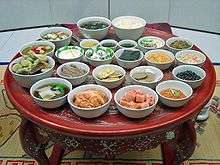Dasik
 | |
| Type | Hangwa |
|---|---|
| Place of origin | Korea |
| Main ingredients | Nongmal, rice flour, honey, pollen |
|
| |
| Dasik | |
| Hangul | 다식 |
|---|---|
| Hanja | 茶食 |
| Revised Romanization | dasik |
| McCune–Reischauer | tasik |
Dasik (Korean pronunciation: [taɕʰik] is a traditional Korean confectionery (literally “tea food” in Chinese characters).[1] It is a variety of hangwa, or Korean confectionery, that is mainly eaten with Korean tea. This type of cookie is lighter and healthier than Western snacks and it is not as sweet as cookies or chocolates.[2]
It is made from nongmal (which is starch made from potatoes, sweet potatoes or soaked mung beans), pine pollen (songhwa), Ostericum grosseserratum (singamchae), black sesame, honey, flour from rice or other grains, nuts and/or herbs.[3][4][5]
Dasik is kneaded and pressed with dasikpan (다식판), decorative stamps for making patterns on dasik.[6] Depending on their ingredients, dasik comes in white, yellow, black, green, brown or reddish.
Variety
- Heukimja dasik (흑임자다식), made with black sesame seeds
- Kong dasik (콩다식), made with beans
- Songhwa dasik (송화다식), made with pollen powder
- Bam dasik (밤다식), made with chestnut
- Jinmal dasik (진말다식), made with wheat flower and honey
- Nongmal dasik (녹말다식), made with starch
- Ssal dasik (쌀다식), made with rice flour
Origin
Introduced to Korea some 1,600 years ago from India was Buddhism and that included the tea culture, along with its religious practices and teachings. Tea was first influenced in the culinary culture of Korean royalty and later reached to the upper classes. Due to Korea’s climate, it was unsuitable to cultivate, which it was difficult for the elite class to enjoy tea. For Buddhist ceremonies, it was usually prepared, making the temples the center of Korea’s tea culture.
The tea culture flourished during the Goryeo Dynasty (918-1392) and promoted the virtues of Buddhism. During the Joseon Dynasty (1392-1910), tea culture declined as the ruling class adopted Confucian doctrine. The tea culture from Korea eventually reached Japan, which embraced other cultural influences.
Hardships of farming not only affected men, but women as well who looked after children and prepared meals after a long day of working in the fields. The government designated one day each month where culinary delicacies were prepared as a way to promote a healthy family life and to free women from some of their daily burden. Of these monthly celebrations included Seollal, New Year’s, the first day of the first lunar month and Chuseok, Harvest Moon Festival, the fifteenth day of the eighth lunar month, when the harvest begins, making it the most abundant time of the year. During these holidays, ancestors were honored with food offerings and would pour alcoholic beverages in a ceremony called charye, a name that came from serving tea or cha to ancestors. The offerings included meat, fish, fruit, and special delicacies, often decorated elaborately. Gokcha, a type of wine and was sometimes used instead of tea. Now, wine is more included instead of traditional tea.
Families that emphasize formality, the color of the dasik is carefully chosen. The desired taste, color and texture are taken into account during the process of selecting the ingredients and the processing. Dasik arrangements are by color, served on a serving plate that reflects the artistic sense of the host and it sets the tone of the celebration.[7]
Dasikpan
Dasik is shaped with a wooden or porcelain press that forms a patterned confectionery. The press is engraved with a design that forms an embossed pattern on the dasik piece. The design would symbolize the family's name in order to wish for a long life or for a special event, like hwangap or 60th birthday or weddings.[8] Press the dough into a Dasikpan that has letters, flowers or a geometric pattern is embossed. The surface of dasik has letters, flower patterns, or Chinese letters 壽·福·康·寧 representing long life, luck, health and peacefulness. Two dasikpan forms one set. Its length is 30∼60㎝, width is 5∼6㎝, and thickness is 2∼3㎝.
See also
References
- ↑ Chun Su jin (2007) Sweet treats for teatime snacks Korea JoongAng Daily web: http://koreajoongangdaily.joins.com/news/article/article.aspx?aid=2883159 Retrieved on: 8 November 2014
- ↑ Meyer, Chad (2008) Uniqueness of Korean Desserts The Korea Times Web:https://www.koreatimes.co.kr/www/news/culture/2014/07/318_32072.html Retrieved on: 8 November 2014
- ↑ "Kinds of Hangwa". Dasik (Pattern pressed cake). Korea Agro-Fisheries Trade Corporation. Retrieved 2008-06-02.
- ↑ "Dasik (다식 茶食)" (in Korean). EncyKorea. Retrieved 2008-06-02.
- ↑ Pyojun gugeo daesajeon: dasik
- ↑ "The official website of the Republic of Korea". Korea.net. Retrieved 2013-05-12.
- ↑ Koo Chun-sur (2002) Dasik: A Unique Delicacy to Accompany Tea Koreana A Quarterly on Korean Art & Culture web:http://koreana.kf.or.kr/view.asp?article_id=4606&lang=English Retrieved on 7 November 2014
- ↑ Koo Chun-sur Dasik: A Unique Delicacy to Accompany Tea Koreana A Quarterly on Korean Art & Culture web: http://koreana.kf.or.kr/view.asp?article_id=4606&lang=English Retrieved on: 7 November 2014
External links
- Dasik: Unique Delicacy to Accompany Tea
- Sweet treats for teatime snacks article at JoongAng Ilbo
- "다식 : 지식백과". Terms.naver.com. Retrieved 2013-05-12.
 |
| This article is part of a series on |
| Korean cuisine 한국 요리 조선 료리 |
|---|
|
|